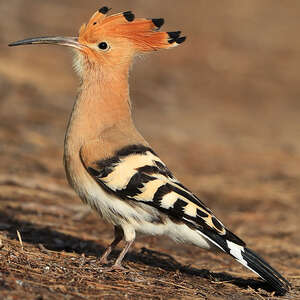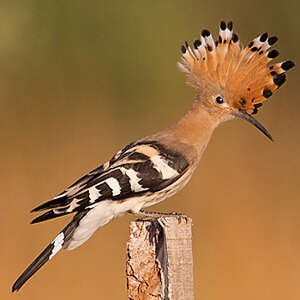Eurasian Hoopoe
Upupa epops - Huppe fasciée
Identification
At first glance, the Eurasian Hoopoe is immediately recognizable. Its overall look, the reddish plumage, black and white wings and tail, and its long, erect crest and curved, beak make it a remarkable bird. The three species of hoopoe look very similar and their differences are subtle.
The Eurasian Hoopoe can be distinguished by its black wing bars crossed with white (wholly black in its South African counterpart), and the white subterminal zone of the crest feathers.
Otherwise, it suffices to look at a photo to get a sense of the bird. A lengthy description is superfluous. On the sitting bird, the noticeable features are the reddish, often bristled crest, the head, the sandy-coloured neck and mantle, the visible black-and-white barred wing, and the lengthy, grey, curved beak. When the bird is in flight, it is the wide, round, black and white-barred wings and the bird's particular flapping that attract attention.
There is no obvious sexual dimorphism. The female is just a bit smaller and paler.
The juvenile looks like the female, but duller, with a shorter crest and beak.
Subspecific information 8 subspecies
- Upupa epops epops (nw Africa and Europe e to sc Russia, nw China and nw India.)
- Upupa epops saturata ()
- Upupa epops ceylonensis (c and s India, Sri Lanka)
- Upupa epops longirostris (ne India to s China, Indochina and n Malay Pen.)
- Upupa epops major (Egypt)
- Upupa epops senegalensis (Senegal and Gambia to Somalia)
- Upupa epops waibeli (Cameroon to nw Kenya and n Uganda)
- Upupa epops africana ()
Foreign names
- Huppe fasciée,
- Abubilla común,
- poupa-comum,
- Wiedehopf,
- búbosbanka,
- Hop,
- Upupa,
- härfågel,
- Hærfugl,
- dudok chochlatý,
- dudek chocholatý,
- Hærfugl,
- harjalintu,
- puput comuna,
- Herfugl,
- dudek,
- pupuķis,
- smrdokavra,
- Удод,
- Hupo tunggal,
- ヤツガシラ,
- 戴胜,
- นกกะรางหัวขวาน,
- 戴勝,
Voice song and call
The song is quite typical and is part of the soundscape of many rural areas in the spring. It is composed of three equal notes repeated quickly and can be translated as woupwoupwoup. The phrase is repeated at intervals of a few seconds for a period that can last a minute or more.
As much as the song can be described as pleasant, some of its cries are unpleasant to the human ear. The most classic cry, which is the alarm cry when entering the territory, is a harsh waaahhrrr reminiscent of a distant cry of the Grey Heron or even a Crow's cry. Otherwise, there are also whistled sounds resembling the Turdidae, a dry rattle of anxiety and various other cries, especially the pair in their intimacy.
Habitat
The Eurasian Hoopoe is a species that has three requirements for its reproduction period: firstly, an open to semi-open environment with easily accessible ground, either bare soil or sparsely vegetated, for foraging and cavities in trees or rocks for nesting.
For nesting, an old tree with a cavity will do; it can be an isolated tree or part of a structured landscape element such as a tree line, small wood, park, or old orchard, riparian vegetation, trees planted along roads or waterways, and so on. A natural or artificial cliff face, embankment or steep riverside can also be chosen. Often, however, an old building or ruin such as an abandoned shepherd's hut, either isolated in the countryside or in or around a village or hamlet, is chosen. A simple pile of large stones can also occasionally be suitable, like with the Little Owl. These two species are often frequently found in close proximity.
Behaviour character trait
The return of migration of the Eurasian Hoopoes takes place from late March to May. The male's song is the signal of their arrival and the best indicator to spot these birds.
They immediately reoccupy territories left in late summer and take back their habits.The hoopoe is not a very shy bird towards humans. It can even be very anthropophilic as long as is left in peace to do its duties. It can even raise its brood in the heart of a village.
It is not a gregarious bird. Couples reproduce separately on well-defined territories, but if the environment is favorable, two nests may be close to each other, for example in the same hamlet. After reproduction, family groups are observed in the feeding areas.
The hoopoe is a rather demanding bird in terms of habitat. It feeds on large insects and their larvae populations, which tend to decrease in the countryside subjected to pesticides and other weed killers. The presence of hoopoes nowadays is an indication of good ecological health.
The post-nuptial migration departure is early, from the month of August, latecomers may be observed until October.
Flight
When one sees an Eurasian Hoopoe flying, it looks like a large butterfly due to its wide, rounded wings, which are heavily marked in black and white.
Its rapid wingbeats alternating with closed wings phases give its flight an undulating and jerky look, sometimes a little erratic or hesitant. Even though one usually expects to see long, thin wings on a migratory bird, we have to agree that this is not the case with the Eurasian Hoopoe, some of whose populations are migratory and whose long distance flying capacity is very real. It should be noted that its migratory movements are nocturnal, which protects it from predation by diurnal raptors.Dietfeeding habits
The Eurasian Hoopoe is exclusively insectivorous and only feeds on the ground. Its long and curved bill is an adapted tool for digging in soft soil and able to detect prey in the dark and by touch.
Its prey consists mainly of large insect larvae, especially beetles, like the white worms, but also the imagos themselves, such as crickets and grasshoppers, tipule larvae, ant nymphs and even earthworms. Of course, it can also take its prey from the surface of the ground. This diet is that of adults as well as young.It is a bird that absolutely needs a rich and diverse entomofauna to maintain itself. The presence of a couple of Eurasian Hoopoes on a territory is therefore a very good indication of the ecological value of this territory.
Reproduction nesting
The Eurasian Hoopoe is monogamous and territorial. The male marks and defends its territory with its loud song.
As soon as she arrived, usually a bit later than the male, the female starts investing in the reproduction.The nest is built in a cavity, either in old trees or in human construction (see above in the habitat section). An old Woodpecker's lodge in a fruit tree or a hole in an old wall are common situations.
The female lays down, on the ground of the cavity, 5 to 7 grey eggs without any preparation which she incubates alone for around 16 days, being supplied by the male. The chicks fly away when they are around 4 weeks old, leaving behind what some people have named a privy because of its smell. They will still wander around the nest for some time and in August they will leave the site. In Europe, Eurasian Hoopoes only raise one nest per year.
Geographic range
The Eurasian Hoopoe has a very wide distribution in the Old World, from the Atlantic and its islands (Madeira and the Canary Islands) to the Russian Pacific (Khabarovsk region) at middle latitudes. It is absent from the British Isles and Scandinavia on one side, and from Japan on the other.
In Africa, it occupies the Maghreb and a continuous sub-Saharan band from Senegal to Somalia and the extreme north of Kenya with some isolated areas, northwards in southern Algeria, southern Libya, and Egypt, southwards in a small band from Cameroon to Uganda. Further south, it is replaced by another species.
To the east, it occupies the entire Indian subcontinent, including Sri Lanka, and all of Southeast Asia but is missing from Indonesia and Oceania, where it has no equivalent.
The African, Indian and Southeast Asian populations are sedentary, while those of temperate Eurasia are migratory, and winter in the south, in southern Spain and the south of the Mediterranean, in the Maghreb, the Middle East and the Arabian Peninsula, for the majority of European birds.
Threats - protection
IUCN conservation status
concern
in the Wild
threatened
evaluated
Generally, the Eurasian Hoopoe is not threatened. However, there are area restrictions to be noted, in particular in Western Europe, where populations have been declining since the 19th century. This decline seems to continue despite climate changes which should in theory be beneficial to this thermophile bird. The main reason is probably the general impoverishment of the entomofauna of agroecosystems, on which the bird completely depends for its survival. The scarcity of large insects, which is also affecting other birds such as shrikes, is a direct consequence of the massive and widespread use of pesticides, not only in agriculture but also by individual people, with no place truly unaffected. Furthermore, the traditional habitat of the hoopoe, the village with its old houses, hedgerows, surrounding orchards and pastures, its small organic gardens, is shrinking due to lack of maintenance. This is renovating the habitat, depriving the hoopoe of nesting sites. Putting up nesting boxes can help to make up for this lack, but one must remember to do it.
Sources of information
- IOC World Bird List (v15.1), Gill, F and D Donsker (Eds). 2025-12-07.
- Les passereaux d'Europe, tome 1, P. Géroudet, M. Cuisin
- HBW Alive,
- xeno-canto, Sharing bird sounds from around the world,
Other sources of interest
 Specification sheet created on
05/07/2023 by Jean François
Specification sheet created on
05/07/2023 by Jean FrançoisTranslation by AI Oiseaux.net
© 1996-2026 Oiseaux.net
- Accipitriformes
- Aegotheliformes
- Anseriformes
- Apodiformes
- Apterygiformes
- Bucerotiformes
- Caprimulgiformes
- Cariamiformes
- Casuariiformes
- Charadriiformes
- Ciconiiformes
- Coliiformes
- Columbiformes
- Coraciiformes
- Cuculiformes
- Eurypygiformes
- Falconiformes
- Galliformes
- Gaviiformes
- Gruiformes
- Leptosomiformes
- Mesitornithiformes
- Musophagiformes
- Nyctibiiformes
- Opisthocomiformes
- Otidiformes
- Passeriformes
- Pelecaniformes
- Phaethontiformes
- Phoenicopteriformes
- Piciformes
- Podargiformes
- Podicipediformes
- Procellariiformes
- Psittaciformes
- Pterocliformes
- Rheiformes
- Sphenisciformes
- Steatornithiformes
- Strigiformes
- Struthioniformes
- Suliformes
- Tinamiformes
- Trogoniformes


































